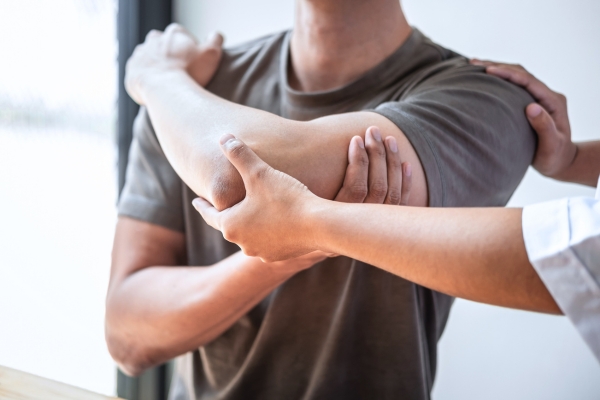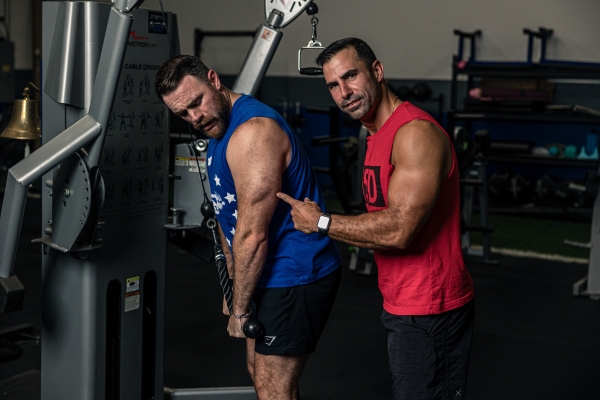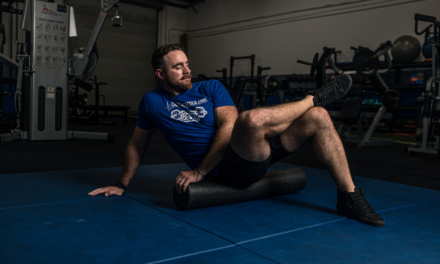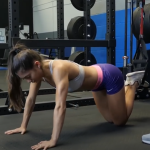Most arm injuries aren’t from accidents—they’re from preventable mistakes.
Whether it’s improper form during your workout or ignoring that nagging pain until it’s too late, many common arm injuries are self-inflicted.
Keeping your arm muscles healthy and injury-free isn’t just essential for your fitness goals—it’s important for everyday tasks like lifting groceries, typing, or even enjoying a hobby like golf or tennis.
In this guide, we’ll cover everything you need to know about how to prevent arm injuries.
You’ll learn about the most common causes of arm muscle injuries, effective strategies for keeping them at bay, and how to manage any injuries that do occur.
Let’s make sure your workouts and daily activities stay pain-free and productive.

Understanding Common Arm Injuries
Understanding these common arm injuries and their symptoms is the first step toward prevention and effective management.
Tendonitis
Repetitive motions and overuse can lead to tendonitis, an inflammation of the tendons.
The most well-known types are tennis elbow (lateral epicondylitis) and golfer’s elbow (medial epicondylitis), both of which cause pain and discomfort in the elbow region, making even simple tasks like gripping or lifting painful.
Bicep and Tricep Strains
These strains occur when the muscle fibers are overstretched or torn, usually during lifting exercises or sudden, forceful movements.
Bicep strains often result from overloading during curls, while tricep strains can occur during pressing movements like bench presses or push-ups.
Rotator Cuff Injuries
The rotator cuff is made up of several muscles and tendons that are key to keeping the shoulder stable.
Rotator cuff injuries frequently occur in athletes and weightlifters, often due to repetitive overhead movements or improper shoulder alignment.
If not addressed early, these injuries can cause ongoing shoulder pain, restricted movement, and long-term problems.
Wrist and Forearm Strains
Wrist and forearm injuries are often linked to repetitive gripping motions or incorrect wrist positioning during exercises like push-ups or curls.
These strains can cause pain, stiffness, and weakness, limiting your ability to perform daily activities and exercise effectively.
Symptoms and Signs
When it comes to arm injuries, being able to recognize the warning signs early can prevent minor issues from turning into major problems.
Common symptoms include:
- Pain: Sharp or dull pain that worsens with movement or specific activities.
- Stiffness: Difficulty moving the arm, especially after periods of rest or in the morning.
- Swelling: Inflammation around the affected area, which may be accompanied by redness or warmth.
- Weakness: Reduced strength when trying to lift, push, or pull objects.
- Reduced Range of Motion: Difficulty fully extending or bending the arm, often leading to compensatory movements that can worsen the injury.

Key Causes of Arm Injuries
Preventing arm injuries starts with understanding what leads to them in the first place.
From poor exercise form to ignoring early warning signs, several factors contribute to the most common arm injuries.
In this section, we’ll break down the key causes so you can identify and correct them before they turn into bigger problems.
Improper Form During Exercise
One of the leading causes of arm injuries is improper exercise form.
Small mistakes can lead to big problems over time, especially during common exercises like bicep curls, pushups, and tricep extensions.
For example, swinging the weight during curls instead of keeping controlled movements places excess strain on the tendons and joints.
In pushups, flaring the elbows too wide can put undue pressure on the shoulders, leading to rotator cuff issues.
Consistently using poor technique may result in strained muscles, irritated tendons, and long-term joint damage.
Overuse and Repetitive Stress
Repetitive movements without adequate rest are a recipe for overuse injuries.
Activities like lifting weights daily without giving your muscles time to recover can lead to inflammation and chronic pain, especially in the tendons.
Even outside of the gym, repetitive tasks like typing, playing an instrument, or performing the same motion repeatedly at work can contribute to arm injuries.
Without enough recovery time, the constant stress placed on your muscles and tendons builds up, leading to conditions like tendonitis and strains.
Lack of Warm-Up and Mobility Work
Skipping the warm-up is another common mistake that increases the risk of arm injuries.
Warming up properly with dynamic stretches and mobility drills prepares your muscles, tendons, and joints for the upcoming workout.
A good warm-up increases blood flow, enhances flexibility, and primes your nervous system for activity.
Without it, your muscles are stiff, and your joints aren’t adequately lubricated, making you more prone to strains, tears, and other injuries.
Incorporating mobility exercises also improves your range of motion, reducing the chance of compensating with improper form during challenging movements.
Ignoring Early Warning Signs
Pushing through mild pain is a surefire way to turn a minor issue into a major injury.
Pain, stiffness, and discomfort are often early signs that something isn’t right, but many people ignore these signals, thinking they can push through.
This mentality leads to worsened injuries over time, from minor strains to full-blown tears that require weeks or months of recovery.
Listening to your body and addressing small issues early on can prevent them from becoming serious, long-term problems.

Injury Prevention Strategies
By following these injury prevention strategies, you can keep your arms healthy, perform exercises more effectively, and avoid setbacks that can derail your fitness goals.
Prioritize Proper Form and Technique
One of the most effective ways to prevent arm injuries is to maintain proper form and technique during exercises.
Whether you’re doing bicep curls, pushups, or shoulder presses, always focus on controlled movements and avoid swinging or jerking motions.
Keep your elbows close to your body during curls and ensure your wrists stay neutral during pushing or pulling movements.
When it comes to progressively overloading your muscles, do so gradually—small increases in weight or reps over time will help you build strength without straining your joints or tendons.
Incorporate Strength and Mobility Work
Strengthening the stabilizing muscles around your shoulders, elbows, and wrists is crucial for injury prevention.
Exercises like rotator cuff strengthening drills, wrist curls, and resistance band work for shoulder stability can enhance your joint integrity and reduce the risk of strains.
Additionally, regularly incorporating mobility exercises like arm circles, band pull-aparts, and shoulder dislocations helps improve your range of motion and flexibility, making it easier to perform exercises with proper form and reducing the risk of overcompensation.
Warm-Up and Cool-Down Routine
An effective warm-up sets the stage for a safe workout, while a proper cool-down aids in recovery.
Start your warm-up with dynamic stretches like arm swings, shoulder rotations, and light resistance band exercises to get the blood flowing and loosen up the joints.
For your cool-down, include static stretches like tricep stretches, cross-body shoulder stretches, and wrist flexor stretches.
Cooling down also helps flush out lactic acid and prevents stiffness, setting you up for your next workout.
Listen to Your Body and Rest
Knowing the difference between soreness and pain is essential for staying injury-free.
Soreness is a natural result of working out and indicates muscle growth, but sharp or persistent pain is often a sign of an injury.
If you feel discomfort that doesn’t improve with rest or stretching, it’s time to back off and reassess your routine.
Prioritizing rest days and incorporating active recovery, like light cardio or stretching, helps your muscles and joints recover, reducing the risk of overuse injuries.

Stay Strong, Stay Safe: Preventing Arm Injuries
Preventing arm injuries is all about smart training, proper form, and listening to your body.
By focusing on good technique, incorporating mobility and strength exercises, and ensuring you warm up and cool down properly, you can significantly reduce the risk of common arm injuries like tendonitis, strains, and overuse injuries.
Remember to gradually progress in your workouts, take rest days seriously, and pay attention to any warning signs your body gives you.
Ready to take your injury prevention game to the next level?
Try our Easy Mobility Routine program—designed specifically to keep your arms injury-free while improving flexibility and strength.















































































